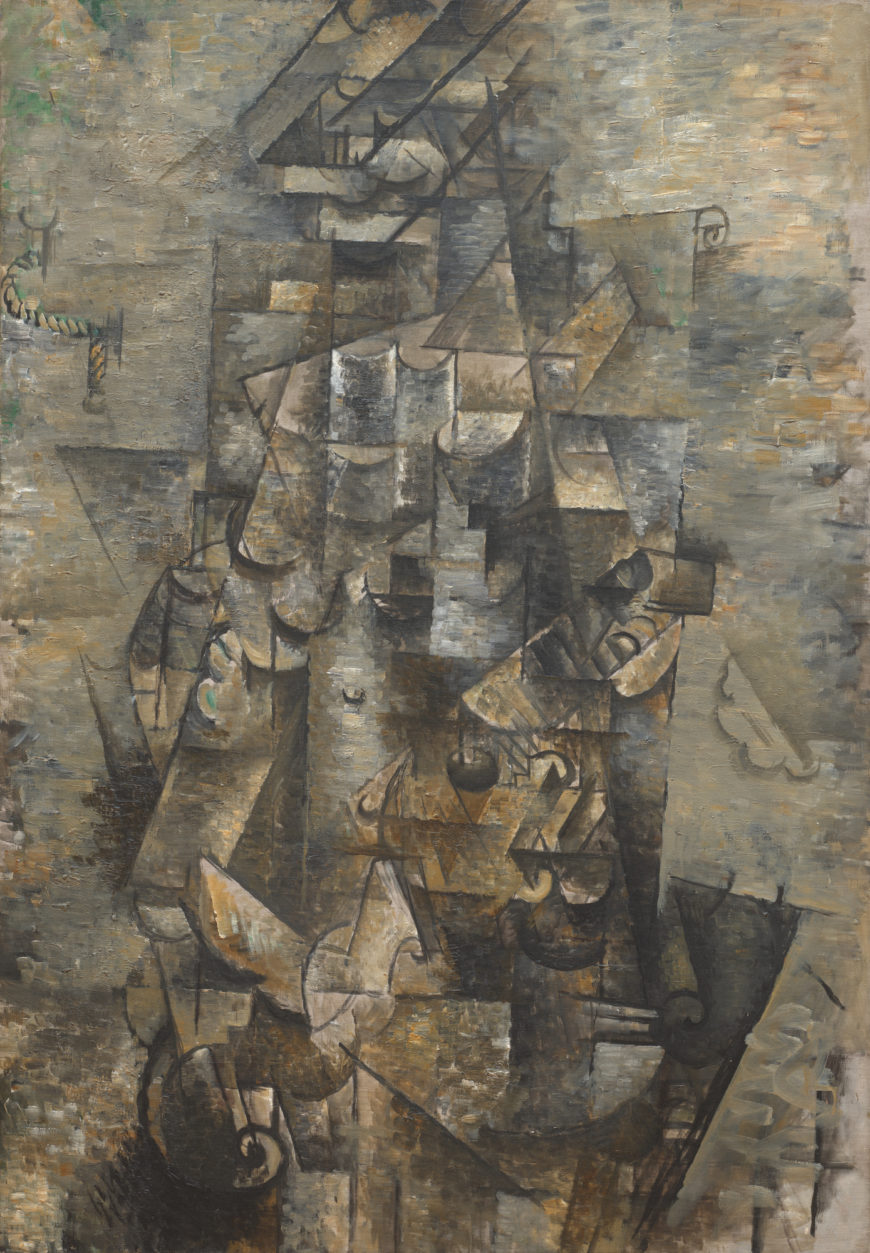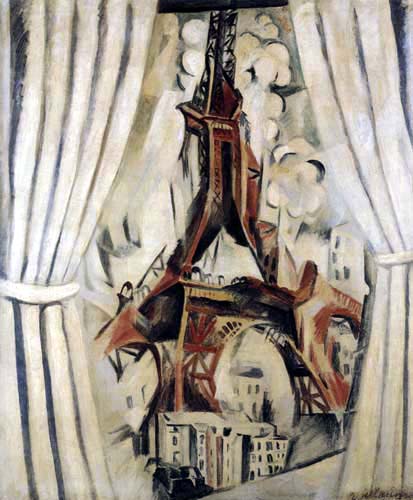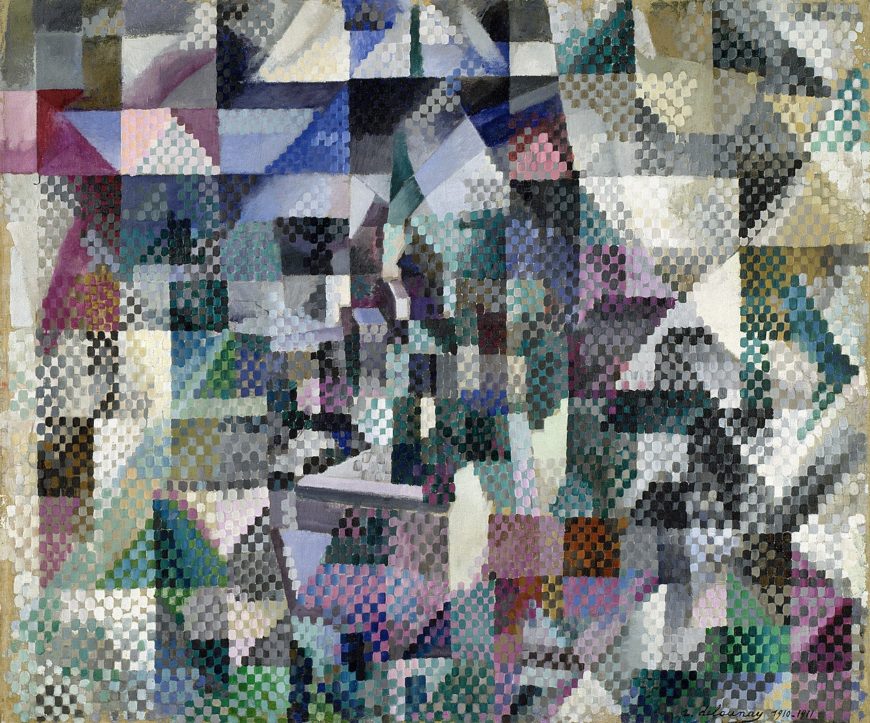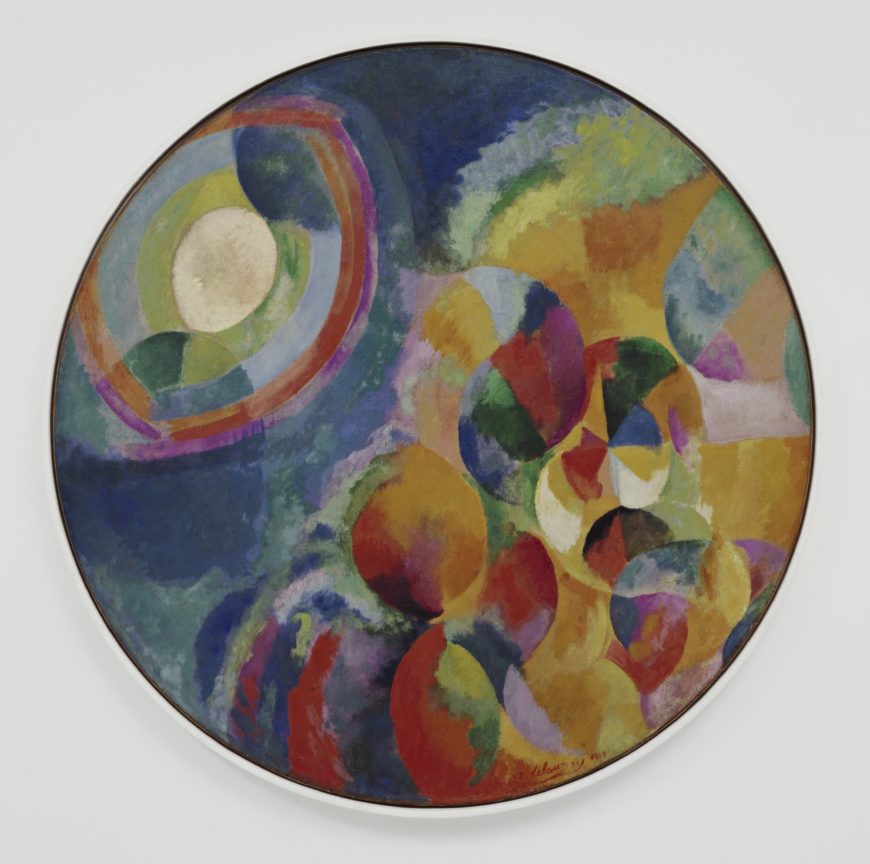
Robert Delaunay, Simultaneous Windows on the City, 1912, oil on canvas, 40 x 46 cm (Kunsthalle Hamburg)
Robert Delaunay’s Simultaneous Windows on the City is enigmatic. Where is the city? Where are the windows? At first (and possibly second and third) glance what we see is a fractured pattern of mostly rectangular planes painted in the colors of the spectrum over both a canvas and its wooden frame. If we consider the post-Renaissance Western conception of a painting as being like a window, then we might interpret the painted frame as a window frame and the canvas inside as representing the city, but this does little to help us see a city depicted in the painting.
Cubist composition
Looking at the painting in Cubist terms is more successful. Delaunay exhibited with the Salon Cubists, and this painting was made as Delaunay’s artistic interests shifted from the Cubists’ analysis of form to an investigation of color and light.

Georges Braque, Man with a Guitar, 1911, oil on canvas, 45 3/4 x 31 7/8 inches (MoMA)
Despite its intense color, Simultaneous Windows on the City remains Cubist in overall composition. Like Braque’s roughly contemporary Cubist composition Man with a Guitar, Delaunay’s painting is a complex grid of dark and light-toned planes and ambiguous forms in which the viewer can find vestigial signs of the subject.

Robert Delaunay, Simultaneous Windows on the City, 1912, detail (Kunsthalle Hamburg)
The most recognizable form in Delaunay’s painting is the green Eiffel Tower in the center, rising up from its triangular base to a point toward the top of the canvas. Below the tower are suggestions of rectangular buildings with dark blue windows. Some of these are painted directly on the wooden frame, indicating that it cannot be literally equated with a window’s frame.
The side bars of the frame are, however, darker than the canvas area, and their diagonal edges at the top and bottom create the illusion of a casement window opening into the viewer’s space. The bright yellows and oranges on the canvas convey an impression of warm outdoor light, while the intense blues in the rectangle surrounding the Eiffel Tower suggest sky. The color contrasts also create a sense of spatial depth as the cool blues appear to recede next to the vivid warmth of the yellows and oranges.
An established subject
Delaunay painted many depictions of both the Eiffel Tower and Paris as seen from a window, and this painting is a more abstract version of what was an established subject for him.

Robert Delaunay, The Tower with Curtains, 1910, oil on canvas, 116 x 97 cm (Kunstsammlung Nordrhein-Westfalen, Düsseldorf)
Knowledge of his earlier paintings makes it easier to see the representational forms in this one. The orange shapes, for example, are like the curtains in the windows that frame the tower in previous paintings. Here, however, their color also plays a crucial role, suggesting sunlight and creating a chromatic contrast with the blue that intensifies both colors.
Simultanism and Orphism
The use of chromatic contrast is a primary interest in Simultaneous Windows on the City, and became a central concern of Delaunay’s art. He studied the science of vision and color theory, particularly the writings of M. E. Chevreul and Ogden Rood, which had influenced the Neo-Impressionists in the 19th century.

Robert Delaunay, Window on the City no. 3, 1911, oil on canvas, 113.7 x 130.8 cm (Solomon R. Guggenheim Museum, New York)
Delaunay used the Neo-Impressionists’ divisionist technique to create a visible mosaic of colored brushstrokes in paintings like Window on the City no. 3, but he soon shifted to using larger planes of color. In 1912 he and his wife Sonia developed an approach to painting light by means of color that they called Simultanism.
The Delaunays were not alone in using the term Simultanism in relation to art. Simultaneity was a popular term with broad significance among avant-garde artists and writers of the time. Generally, it alluded to new concepts of space and time described by early-20th century physicists, such as Einstein, and philosophers, notably Henri Bergson. More specifically, it referred to techniques used by Cubists and Futurists to combine different vantage points into a single “simultaneous” image. Such images were considered a synthesis of memory and perception, and sometimes also a synthesis of many different people’s views.
The Delaunays’ friend, the writer Guillaume Apollinaire, labelled their work “Orphism” or “Orphic Cubism,” and linked it with the work of other artists who were also developing post-cubist styles. Despite Apollinaire’s confusing combination of very different artistic styles and approaches into a single category, the term Orphism has endured. It is sometimes used as a synonym for Simultanism or, more generally, to refer to abstract painting that uses color in a manner comparable to the use of sound and rhythm in music.

Robert Delaunay, Simultaneous Windows on the City, 1912, oil on canvas, 40 x 46 cm (Kunsthalle Hamburg)
The complexity of vision
As we look closely at Simultaneous Windows on the City we experience the complexity of vision. The fractured planes of different colors mimic the way light reflects off glass and how when we look out a window we can often simultaneously see the view outside and reflections of objects inside. Perhaps the curved orange and yellow planes on the right are not a curtain but the reflection of a head and neck with an ear jutting out next to the Eiffel Tower.
The longer you look at the painting the more possible readings of the suggestive forms you are likely to discover. Delaunay’s painting is not only about vision, it is also about painting itself and the way its colored shapes and relationships structure vision. We are led to realize this because the lack of clear representational imagery constantly reminds that we are looking at colors painted on the flat surface of the canvas.
Between abstraction and representation
The Delaunays’ Simultanist paintings explore the potential of color contrasts to create form and depth.

Robert Delaunay, Simultaneous Contrasts: Sun and Moon, 1912, oil on canvas, 134.5 cm diameter (MoMA)
They often hover ambiguously between pure abstraction and representation, particularly the paintings that take the light of celestial objects as their subjects, such as Robert’s Simultaneous Contrasts: Sun and Moon. A few are clearly non-representational, while others depict specific subjects, ranging from street lamps to dance halls and airplanes.

Robert Delaunay, Homage to Blériot, 1914, tempera on canvas, 250 x 250 cm (Kunstmuseum Basel)
The modern experience
In adopting the term Simultanism to describe their paintings, the Delaunays combined reference to a famous text on color theory with recent philosophical and scientific explorations of perception and memory. The art they produced reflected this combination in its synthesis of formal concerns and modern subject matter.
Additional resources:
Read Ogden Rood’s Modern Chromatics at the Linda Hall Library Foundation

